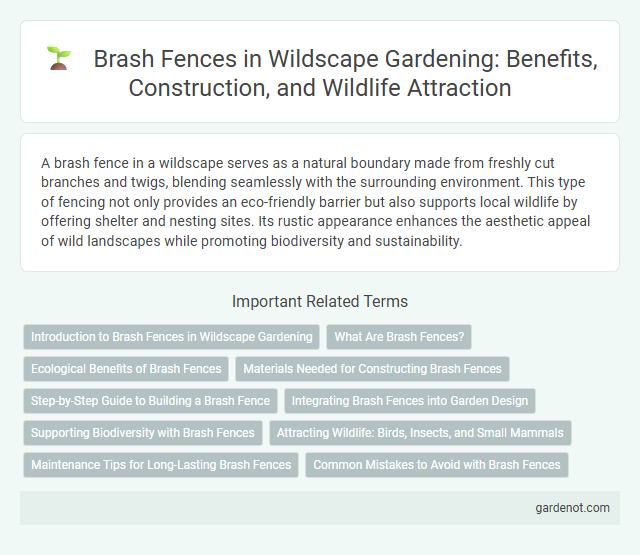A brash fence in a wildscape serves as a natural boundary made from freshly cut branches and twigs, blending seamlessly with the surrounding environment. This type of fencing not only provides an eco-friendly barrier but also supports local wildlife by offering shelter and nesting sites. Its rustic appearance enhances the aesthetic appeal of wild landscapes while promoting biodiversity and sustainability.
Introduction to Brash Fences in Wildscape Gardening
Brash fences in Wildscape gardening utilize natural, untreated branches and twigs to create eco-friendly boundaries that blend seamlessly with the environment. These fences provide essential habitats for local wildlife, supporting biodiversity by offering shelter and nesting sites. Incorporating brash fences enhances garden sustainability while promoting natural ecosystem interactions.
What Are Brash Fences?
Brash fences are structures made from natural materials like branches, twigs, and brushwood, designed to create habitats that support biodiversity. These fences provide shelter and nesting sites for various wildlife species, including birds, insects, and small mammals, while promoting natural regeneration in wildscape projects. By integrating brash fences into landscapes, conservation efforts enhance ecosystem connectivity and resilience.
Ecological Benefits of Brash Fences
Brash fences provide essential habitats for a variety of wildlife, promoting biodiversity by offering shelter and nesting sites for birds, insects, and small mammals. These structures support soil health by reducing erosion and enhancing nutrient cycling through the natural decomposition of organic materials. By integrating brash fences into wildscape management, ecosystems benefit from improved connectivity and resilience, fostering a balanced and thriving environment.
Materials Needed for Constructing Brash Fences
Constructing brash fences requires natural materials such as cut branches, twigs, and brushwood typically sourced from local woodland areas to ensure ecological compatibility. Strong stakes or wooden posts are necessary to anchor the brash securely into the ground, providing structural stability. Binding materials like natural twine or wire help in tightly fastening the brash together to create an effective wildlife barrier.
Step-by-Step Guide to Building a Brash Fence
Constructing a brash fence begins with gathering natural materials such as branches, twigs, and brushwood to provide a sturdy framework. Start by placing upright wooden stakes at regular intervals, typically 2 to 3 feet apart, ensuring they are firmly anchored in the ground for stability. Weave the collected brash horizontally between the stakes, overlapping layers to create a dense barrier that offers effective shelter and habitat for wildlife in the wildscape.
Integrating Brash Fences into Garden Design
Integrating Brash Fences into garden design enhances biodiversity by providing natural habitats for insects, birds, and small mammals while adding rustic texture and visual interest. These fences, crafted from locally sourced twigs and branches, blend seamlessly with natural landscaping, supporting wildlife corridors and sustainable gardening practices. Strategically placed Brash Fences can act as windbreaks and natural barriers, promoting ecological balance and enriching the garden's structural diversity.
Supporting Biodiversity with Brash Fences
Brash fences create essential habitats by providing shelter and nesting sites for invertebrates, birds, and small mammals, enhancing local biodiversity. These natural structures foster microhabitats that support decomposers and pollinators, crucial for healthy ecosystems. Integrating brash fences into conservation areas promotes ecological connectivity and resilience against habitat fragmentation.
Attracting Wildlife: Birds, Insects, and Small Mammals
Brash fences provide essential habitat by offering dense cover and nesting sites that attract a variety of birds, insects, and small mammals. The arrangement of woody debris creates microhabitats supporting biodiversity, encouraging pollinators like bees and butterflies to thrive. These natural structures also offer shelter and foraging opportunities, enhancing local wildlife populations and ecosystem health.
Maintenance Tips for Long-Lasting Brash Fences
Regularly inspect brash fences for signs of rot, insect damage, or loose bindings to maintain structural integrity. Apply natural preservatives such as linseed oil or eco-friendly wood treatments to protect against weathering and decay. Clear surrounding vegetation and debris to ensure proper airflow and prevent moisture buildup, extending the lifespan of the brash fence.
Common Mistakes to Avoid with Brash Fences
Common mistakes to avoid with brash fences include improper stacking that compromises stability and creates hazards for wildlife. Using green or untreated brash can lead to rapid decay and reduced fence longevity, undermining effectiveness in habitat protection. Ensuring adequate height and secure anchoring prevents gaps that allow predators to access protected areas.
Brash fence Infographic

 gardenot.com
gardenot.com